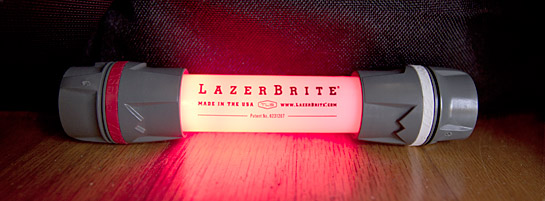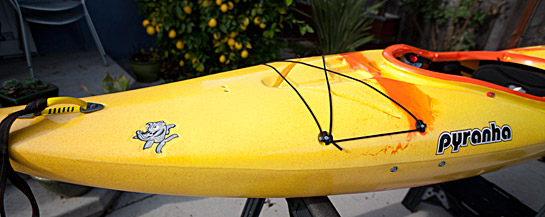
Not Quite Commonplace
I’ve been in the market for a boat that fits in the FSK – fast sea kayak – category. This broad category of boats is typified by being very long, very narrow, very fast, and able to hold a healthy amount of cargo. I can neither afford nor store one expedition boat and one racing boat – I needed a kayak that exhibited characteristics of both but didn’t have huge tradeoffs that made it suck for both extended trips and competiton.
This is a burgeoning category for sea kayaks (filled with amazing boats like the Tiderace Xplore, Epic 18x Sport, Rockpool Taran, Current Designs Nomad GTS, and many more), yet in the big scheme of things, it’s a pretty niche market. Looking for such a craft in the Bay Area is like trying to find dedicated downhill-only mountain bikes in a Kansas bicycle shop. It was really hard to find any examples of these boats to try here in Northern California. It’s even hard to find common large-volume expedition boats around here, even the standard-volume Valley Nordkapp and the P&H Cetus HV!
An upcoming summer trip made me want to pull the trigger sooner than later, though: I’m not about to put my life in a craft that I’ve not gotten to know pretty well, and waiting for boats to arrive with unsure delivery dates felt like a gamble. (I’ll keep paddling competing craft as they become available!)
On the East Coast and in the Midwest, QCC is a well-known American brand, but you don’t see many here on the West Coast. Their kayaks are odd ducks for those of us that love ocean whitewater, rock gardens, and who use highly maneuverable day-tripping kayaks like the P&H Delphin. QCC boats have nearly plumb bows, little visible rocker (what QCC recommends should be called “upsweep” – whatever, we all call it rocker), and a rudder. QCC’s largest boat, the Q700x, is a full 18 feet long and only 21″ wide.
It was a good match for my needs. I wanted a fast, race-worthy boat that also could support me for at least a week at a time without resupply. It had a set of design compromises that I was willing to live with. I had a chance to use a friend’s Q700x for a test paddle, and then to buy one on the used market (this is the first used boat I’ve ever owned: Model year 2008). Sold.
It’ll put me in a different class for competitions, but I’m ready for the (probably very humbling) challenge!
Overall Impressions
This boat had only been launched three times by its previous (only) owner, so it was in great shape. I found the manufacturing to be decent; there are gaps in the sealant around the rear bulkhead, and the deck seam isn’t as clean as those found on, say, Current Designs kayaks. Its carbon-kevlar layup is thin, make no mistake, more flexible and lighter than what I’m used to with British-style boats from manufacturers like P&H. I’m an ultralight backpacker, so weight capacity isn’t that big of an issue, but I’ll have to treat it with more care than my P&H Capella 163.
In terms of handling it feels somewhat similar to an Epic 18X, from an end-consumer perspective as a result of testing boats (meaning short amounts of time in the saddle of each). More on its first full day on the water is below.
I was pleased to see that this boat didn’t have traditional push-the-footpeg-to-turn rudder controls. The Smart Track rudder is quite effective for its size, and its toe-pedal steering is a godsend for those of us who are serious about leg drive during the forward stroke. For long crossings and racing, rudders offer an efficiency that’s hard to beat by reducing the amount of corrective strokes you need to take. I’ve not been in a ruddered boat for about three years, but I’m looking forward to something different after many British-style, skegged boats (which I still adore, and prefer, for day tripping).
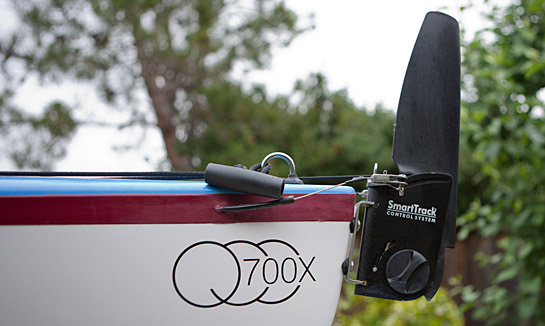
Fit and Cargo
QCC boats have another interesting attribute: The cockpit sizes are the same across a wide range of boat sizes. I suppose that I’m considered a “smaller paddler” by manufacturers’ standards: 5’11”, 160 lbs., 32″ inseam, US size 8.5 (Euro 42) feet…and yet this long boat fits very well. Few kayak manufacturers seem to make big-cargo boats for not-so-big paddlers, since most manufacturers scale up cockpit dimensions with hatch dimensions. Not so with the Q700x, which (for me) results in positive contact with the deck, making for more confident maneuvering, edging, and rolling.
QCC doesn’t publish storage or hatch volumes on their website, but in my initial packing tests, I managed to fit at least 70L of dry bags in the front hatch and 90L of dry bags in the rear, with many gaps that could easily be filled with other gear. I’d guess that these would be something like 85L front and 115L rear if published as manufacturer’s specs. There is no day hatch or “glove box” front hatch. While I won’t miss either, the large front and rear hatches are a burden to open and seal properly while on the water, partially due to how tightly they seal. This is good for peace of mind, and a challenge if a hatch needs to be opened in an emergency. Proper placement of possibly-needed items is going to be important.
For committed wilderness campers, note that the front compartment would fit a bear canister, but the front hatch is 1″ too narrow…while the rear hatch will swallow one but the rear compartment is 0.5″ too shallow. If you fit one in front of the footpegs, be warned that you can’t put the footpegs farther than four notches forward without the rudder controls pushing against the bear canister, preventing the rudder from working properly. You’ll probably need an inseam of 30″ or less to make that work. I’ll be getting several flexible Ursacks in order to properly prevent critters from being fed while on camping trips.
On the Water
As of this writing, I’m still finding my way around the Q700x, but I opted for a rather intense maiden voyage: A 34-nautical-mile non-race endurance event called “The Gonzo,” in which paddlers must reach every island in the San Francisco Bay (there are about 15 of them).
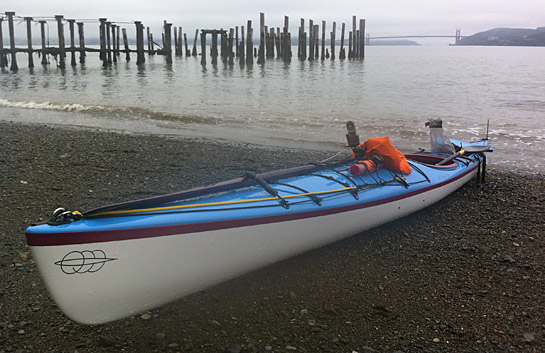
Winds were never over 12kt and generated wind waves less than 18″ high, but they varied from abeam to following to headwinds. I paddled it with a Greenland paddle (84″ long, 20″ loom, 3.625″ wide) and a wing paddle (set to 210cm), carrying only about 10 pounds of cargo.
The boat was well-mannered in these conditions. I’d characterize the Q700x as having low-to-medium primary stability at rest, excellent primary stability underway, and medium secondary stability. It has a nearly rounded hull and soft chines of good height, adding to its stability on edge, and its low deck prevents excessive freeboard when unloaded. It fits my paddling style and sense of balance quite well. It’s the kind of boat you need to stay loose in, and just let it ride, trusting its inherent ability to stay upright. It loves to run downwind and can surf even the tiniest of following waves or swell. Sure, it’s an 18′ boat with little rocker, so it doesn’t turn on a dime, but edged it turns decently considering its length, especially when the rudder was retracted.
Speaking of its length: Hell yeah, it’s fast. It’s already earned the nickname “Bottlerocket” after the first paddle. Long + narrow + soft chines = speed, usually. With a wing paddle and a strong paddler, it’s like a javelin, especially on downwind runs with small following seas.
The small cockpit fit well, and its low front deck allowed for comfortable low-angle cruising strokes. Its narrow beam made high-angle sprints a breeze. The boat is long enough that I could carry my full-size Greenland paddle as a spare with no overhang past the bow!
The rudder is extremely effective for its small size, and the gas pedal style footpegs were easy to reach and actuate. I can see why the Smart Track system has a loyal following. I should have remembered to retract the rudder foil and test for weathercocking, but I did not. With the rudder, if it weathercocked, it was not noticeable in the least. The Q700x has little freeboard for a kayak of its size, which might also help.
I found a little water in the rear hatch after 8 hours of splashy paddling, but I am guessing that came in from my cockpit via the bulkhead instead of the hatches due to some sloppy finishing described earlier in this article. The hatches do seal tightly – so tightly that one must take care making sure that the boat is laid flat somewhere for sealing and opening the hatches. A lot of leverage is needed to pop the hatch seal. Confidence-inducing, but it takes some work to remove!
This all bodes well for getting this boat into more exposed coastal waters and bigger conditions, which will definitely happen in the coming months! It will be interesting to see how it holds up on a 2-week trip alongside the other long, large-capacity boats of my paddling partners, including the Current Designs Isle and the Current Designs Infinity.
Up Next..!
My next article will cover some minor modifications to the Q700x that made it work better for me – and keep an eye on the blog this summer for more info on my adventures that will involve this interesting fast touring boat, and how my assessment of its behavior and performance evolves in different conditions. Stay tuned!
Read More

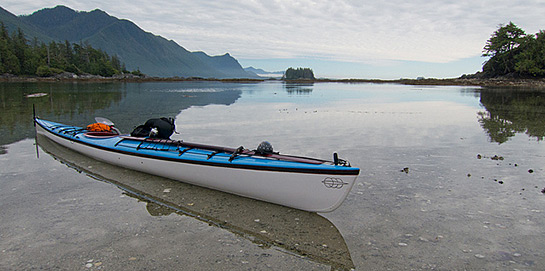
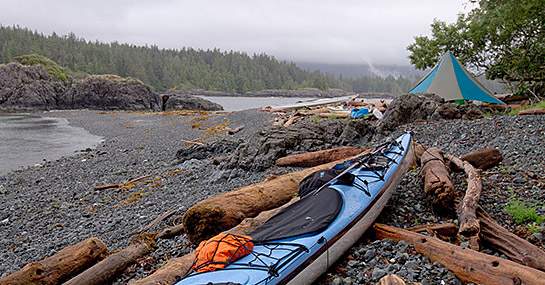
![Nikon 1 AW. [Image by Nikon]](http://www.brinestorm.com/wp-content/uploads/2013/09/nikon1aw.jpg)
![New Trent Powerpak Xtreme [Image by New Trent]](http://www.brinestorm.com/wp-content/uploads/2013/09/ntPPX_vert.jpg)
![Road Shower [Image by Joel Cotton]](http://www.brinestorm.com/wp-content/uploads/2013/09/roadShower.jpg)




